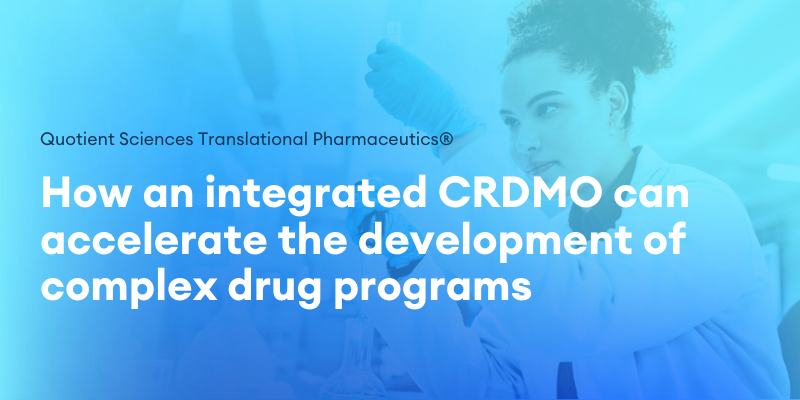Drug development has its challenges, but when it comes to programs that require specialized formulation expertise, such as applying solubility enhancement techniques to improve a poorly soluble API, the challenges in achieving clinical and commercial success are even greater.
All drug development programs are challenging, given the numerous stages an active lead molecule or new chemical entity (NCE) must transition through to gain regulatory approval and demonstrate its benefits in patients. The challenges in achieving clinical and commercial success are even greater for complex programs requiring specialized formulation expertise, such as solubility enhancement or modified release, and in developing suitable formulations for pediatric patients.
At Quotient Sciences, our scientific teams leverage our integrated capabilities as a contract research, development, and manufacturing organization (CRDMO), along with decades of expertise in drug development, to support our customers through even the most challenging drug programs.
Using our flagship platform for drug development, Translational Pharmaceutics®, we integrate real-time cGMP manufacturing with clinical testing—all done within a single organization and under the guidance of a single program manager—to remove conventional siloes in drug development. This approach can aid formulation design with the ability to screen a range of technologies and dosage forms using biorelevant in-vitro screening tools and physiologically based in-silico models to flag developability problems, before quickly transitioning drug candidates into human pharmacokinetic (PK) studies to understand a molecule's full potential for success.
Below, continue reading case studies that explore how Quotient Sciences' integrated CRDMO services and Translational Pharmaceutics® have been applied to overcome formulation challenges in complex drug programs. You can also learn more about how Translational Pharmaceutics® works in this video.
Formulation development and screening of solubility-enhancing formulations
Poor aqueous solubility, leading to solubility-limited exposure, has been recognized as a major challenge in the development and evaluation of NCEs during early discovery, pre-clinical, and clinical development stages. There are various formulation strategies to improve solubility, with the primary goal of improving oral bioavailability.
Our approach to solubility enhancement is based on an understanding of molecular properties, using the Developability Classification System (DCS) to choose the most appropriate formulation approach for a molecule. Understanding the drivers of poor exposure to a drug allows formulation efforts to be focused on appropriate techniques that provide meaningful improvements for in-vivo performance. We have the capability to evaluate chemical modifications, such as salt and polymorph screening, and physical modifications, such as particle size reduction, complexation, solubilization using a lipid-based approach, and stabilization using amorphous forms. Solubility enhancement can be addressed at different stages.
In one client program, a poorly soluble NCE was facing challenges of low oral exposure, non-linear PK, high variability, and a large positive food effect in the first-in-human (FIH) study. These issues were preventing the client from advancing the compound into patient studies. To overcome these challenges, drug products based on three solubility-enhancing formulation platforms were developed: a micronized formulation using particle size reduction of the active pharmaceutical ingredient (API), a self-emulsifying drug delivery system using a lipid-based formulation, and an amorphous formulation using a spray-dried dispersion. These drug products were produced on a small scale for quick clinical assessment in human subjects without the need to conduct larger-scale, cost-prohibitive process development and lengthy stability programs for multiple technologies.
A two-part study was designed for the drug program:
- In part 1, Translational Pharmaceutics® enabled the integration of clinical manufacturing and dosing in healthy volunteers using a six-period cross-over design to obtain comparative human PK data from the three enabling formulations.
- In part 2, higher doses were administered to establish safety margins for patient studies, and dose linearity was determined based on the area under the curve (AUC).
Integrating solubility-enhancing formulation development, clinical manufacturing, and FIH testing using Translational Pharmaceutics®, a new lead formulation was identified in about 6 months. The formulation overcame the solubility barriers and allowed the compound to progress to patient studies.
Formulation development and optimization of a modified-release (MR) dosage form to meet the target product profile (TPP)
Numerous formulation strategies are available for designing MR dosage forms. One of the key challenges when developing an MR formulation is to identify the in-vivo release rate and dose required to achieve the TPP.
While in-vitro dissolution data are generated to describe formulation release, the assumption that this will represent in-vivo performance is unproven until clinical data are available. Often, with MR formulations, a reduction in overall exposure (AUC) is observed when delivering to lower regions in the gastrointestinal (GI) tract, where absorption can be reduced. Contributing factors include reduced fluid volumes (for dissolution and solubilization), and surface area, and differing permeability. Similarly, there are recognized challenges and risks of using pre-clinical models to design MR formulations due to significant inter-species anatomical and physiological differences.
In these cases, Translational Pharmaceutics® is extremely valuable in identifying the optimal platform, dose, and release rate to meet the TPP of specific molecules of interest.
In this client program, an NCE in development for the treatment of inflammatory diseases was being dosed twice a day (BID) or three times a day (TID) during early trials due to a short half-life and a slower terminal phase. The client wanted to develop a once-a-day (QD) product to increase patient compliance and therapeutic outcomes. The TPP had a lower peak-to-trough ratio compared to the immediate-release (IR) product and coverage of the lowest efficacious concentration over the desired duration. Matrix-based MR dosage forms were proposed to reduce the dosing frequency.
Two studies were designed to achieve these objectives:
- In the first study, matrix minitablets in capsule or monolithic matrix tablets were developed and evaluated using in-vitro dissolution rates of 80% release over 8 and 12 hours. While a QD PK profile was achieved in the fasted state with the slower in-vitro dissolution rate with both types of matrix-based drug products, the formulation was susceptible to a food effect when administered with a high-fat meal. This resulted in most of the exposure occurring within the first 12 hours of dosing, which is not optimal for QD dosing.
- In the second study, building on the first, a proprietary technology platform (DiffCORE™) was evaluated from the client with the goal of overcoming the food effect.
Translational Pharmaceutics® enabled the evaluation of multiple variables in this two-part adaptive clinical study, including formulation modifications, food effect, and dose levels/tablet strengths. Flexibility was maximized by the inclusion of a two-dimensional formulation design space in the regulatory submission, which allowed quantitative changes in release rate and dosing during the clinical study to achieve the desired PK profile. Multiple formulation iterations were tested in the same individuals in both the fed and fasted state within a short timeframe, rapidly identifying the most optimal formulation that enabled QD dosing (2).
Summary
Translational Pharmaceutics® supports drug programs across the full development pathway, with capabilities to:
- Fast-track molecules to FIH, or from FIH to POC
- Optimize clinical formulations through solubility enhancement techniques
- Evaluate novel drug delivery technologies for all routes of administration
We are currently the only outsourcing partner able to offer the ability to develop, manufacture, release, and dose drug products within one organization. This maximizes the probability of success and significantly reduces development time and costs for our customers, getting new medicines to patients faster (3).
The Tufts Center for the Study of Drug Development (CSDD) quantified the platform's major benefits, showing significant savings in reaching key milestones as quickly and efficiently as possible. To read their findings, download a copy of the Tufts report assessing Translational Pharmaceutics.
References
1. Zann V, McKenzie L, Crowley K, Sweet-Smith S, Shabir-Ahmed A, Andreas K, Mountfield R, Milton A. A Phase I Study Allowing Clinical Screening of Multiple Solubility-Enhancement Formulation Technologies, and an Assessment of Food, PPI and Dose Linearity Assessment with the Selected Formulation of BOS172767, in Healthy Volunteers. Poster presented at AAPS meeting, November 2019.
2. Tompson D, Whitaker M, Pan R, Johnson G, Fuller T, Zann V, McKenzie L, Abbott-Banner K, Hawkins S, Powell M. Development of a Once‑Daily Modified‑Release Formulation for the Short Half‑Life RIPK1 Inhibitor GSK2982772 using DiffCORE™ Technology. Pharm. Res. 2022;39(4).doi.org/10.1007/s11095-021-03124-7.
3. DiMasi J and Wilkinson M. The Financial Benefits of Faster Development Times: Integrated Formulation Development, Real-Time Manufacturing, and Clinical Testing. TIRS, June 2020.

